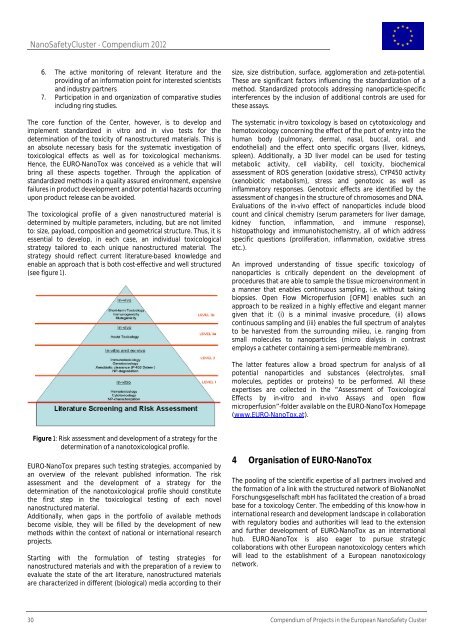Timing, hosts and locations of (grouped) events of NanoImpactNet
Timing, hosts and locations of (grouped) events of NanoImpactNet
Timing, hosts and locations of (grouped) events of NanoImpactNet
Create successful ePaper yourself
Turn your PDF publications into a flip-book with our unique Google optimized e-Paper software.
NanoSafetyCluster - Compendium 2012<br />
6. The active monitoring <strong>of</strong> relevant literature <strong>and</strong> the<br />
providing <strong>of</strong> an information point for interested scientists<br />
<strong>and</strong> industry partners<br />
7. Participation in <strong>and</strong> organization <strong>of</strong> comparative studies<br />
including ring studies.<br />
The core function <strong>of</strong> the Center, however, is to develop <strong>and</strong><br />
implement st<strong>and</strong>ardized in vitro <strong>and</strong> in vivo tests for the<br />
determination <strong>of</strong> the toxicity <strong>of</strong> nanostructured materials. This is<br />
an absolute necessary basis for the systematic investigation <strong>of</strong><br />
toxicological effects as well as for toxicological mechanisms.<br />
Hence, the EURO-NanoTox was conceived as a vehicle that will<br />
bring all these aspects together. Through the application <strong>of</strong><br />
st<strong>and</strong>ardized methods in a quality assured environment, expensive<br />
failures in product development <strong>and</strong>/or potential hazards occurring<br />
upon product release can be avoided.<br />
The toxicological pr<strong>of</strong>ile <strong>of</strong> a given nanostructured material is<br />
determined by multiple parameters, including, but are not limited<br />
to: size, payload, composition <strong>and</strong> geometrical structure. Thus, it is<br />
essential to develop, in each case, an individual toxicological<br />
strategy tailored to each unique nanostructured material. The<br />
strategy should reflect current literature-based knowledge <strong>and</strong><br />
enable an approach that is both cost-effective <strong>and</strong> well structured<br />
(see figure 1).<br />
Figure 1: Risk assessment <strong>and</strong> development <strong>of</strong> a strategy for the<br />
determination <strong>of</strong> a nanotoxicological pr<strong>of</strong>ile.<br />
EURO-NanoTox prepares such testing strategies, accompanied by<br />
an overview <strong>of</strong> the relevant published information. The risk<br />
assessment <strong>and</strong> the development <strong>of</strong> a strategy for the<br />
determination <strong>of</strong> the nanotoxicological pr<strong>of</strong>ile should constitute<br />
the first step in the toxicological testing <strong>of</strong> each novel<br />
nanostructured material.<br />
Additionally, when gaps in the portfolio <strong>of</strong> available methods<br />
become visible, they will be filled by the development <strong>of</strong> new<br />
methods within the context <strong>of</strong> national or international research<br />
projects.<br />
Starting with the formulation <strong>of</strong> testing strategies for<br />
nanostructured materials <strong>and</strong> with the preparation <strong>of</strong> a review to<br />
evaluate the state <strong>of</strong> the art literature, nanostructured materials<br />
are characterized in different (biological) media according to their<br />
size, size distribution, surface, agglomeration <strong>and</strong> zeta-potential.<br />
These are significant factors influencing the st<strong>and</strong>ardization <strong>of</strong> a<br />
method. St<strong>and</strong>ardized protocols addressing nanoparticle-specific<br />
interferences by the inclusion <strong>of</strong> additional controls are used for<br />
these assays.<br />
The systematic in-vitro toxicology is based on cytotoxicology <strong>and</strong><br />
hemotoxicology concerning the effect <strong>of</strong> the port <strong>of</strong> entry into the<br />
human body (pulmonary, dermal, nasal, buccal, oral, <strong>and</strong><br />
endothelial) <strong>and</strong> the effect onto specific organs (liver, kidneys,<br />
spleen). Additionally, a 3D liver model can be used for testing<br />
metabolic activity, cell viability, cell toxicity, biochemical<br />
assessment <strong>of</strong> ROS generation (oxidative stress), CYP450 activity<br />
(xenobiotic metabolism), stress <strong>and</strong> genotoxic as well as<br />
inflammatory responses. Genotoxic effects are identified by the<br />
assessment <strong>of</strong> changes in the structure <strong>of</strong> chromosomes <strong>and</strong> DNA.<br />
Evaluations <strong>of</strong> the in-vivo effect <strong>of</strong> nanoparticles include blood<br />
count <strong>and</strong> clinical chemistry (serum parameters for liver damage,<br />
kidney function, inflammation, <strong>and</strong> immune response),<br />
histopathology <strong>and</strong> immunohistochemistry, all <strong>of</strong> which address<br />
specific questions (proliferation, inflammation, oxidative stress<br />
etc.).<br />
An improved underst<strong>and</strong>ing <strong>of</strong> tissue specific toxicology <strong>of</strong><br />
nanoparticles is critically dependent on the development <strong>of</strong><br />
procedures that are able to sample the tissue microenvironment in<br />
a manner that enables continuous sampling, i.e. without taking<br />
biopsies. Open Flow Microperfusion [OFM] enables such an<br />
approach to be realized in a highly effective <strong>and</strong> elegant manner<br />
given that it: (i) is a minimal invasive procedure, (ii) allows<br />
continuous sampling <strong>and</strong> (iii) enables the full spectrum <strong>of</strong> analytes<br />
to be harvested from the surrounding milieu, i.e. ranging from<br />
small molecules to nanoparticles (micro dialysis in contrast<br />
employs a catheter containing a semi-permeable membrane).<br />
The latter features allow a broad spectrum for analysis <strong>of</strong> all<br />
potential nanoparticles <strong>and</strong> substances (electrolytes, small<br />
molecules, peptides or proteins) to be performed. All these<br />
expertises are collected in the “Assessment <strong>of</strong> Toxicological<br />
Effects by in-vitro <strong>and</strong> in-vivo Assays <strong>and</strong> open flow<br />
microperfusion”-folder available on the EURO-NanoTox Homepage<br />
(www.EURO-NanoTox.at).<br />
4 Organisation <strong>of</strong> EURO-NanoTox<br />
The pooling <strong>of</strong> the scientific expertise <strong>of</strong> all partners involved <strong>and</strong><br />
the formation <strong>of</strong> a link with the structured network <strong>of</strong> BioNanoNet<br />
Forschungsgesellschaft mbH has facilitated the creation <strong>of</strong> a broad<br />
base for a toxicology Center. The embedding <strong>of</strong> this know-how in<br />
international research <strong>and</strong> development l<strong>and</strong>scape in collaboration<br />
with regulatory bodies <strong>and</strong> authorities will lead to the extension<br />
<strong>and</strong> further development <strong>of</strong> EURO-NanoTox as an international<br />
hub. EURO-NanoTox is also eager to pursue strategic<br />
collaborations with other European nanotoxicology centers which<br />
will lead to the establishment <strong>of</strong> a European nanotoxicology<br />
network.<br />
30 Compendium <strong>of</strong> Projects in the European NanoSafety Cluster






